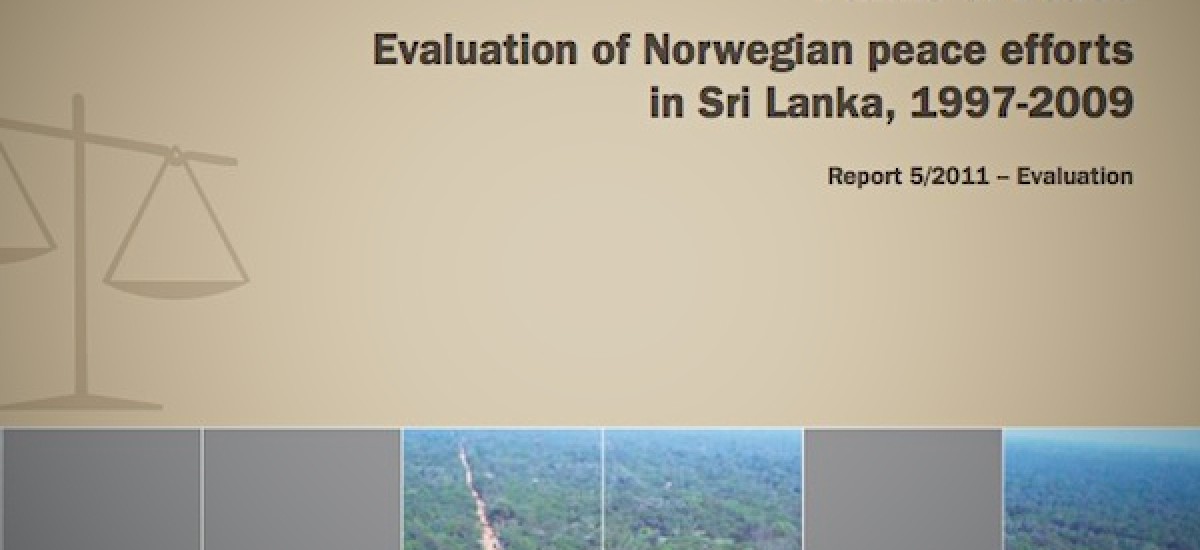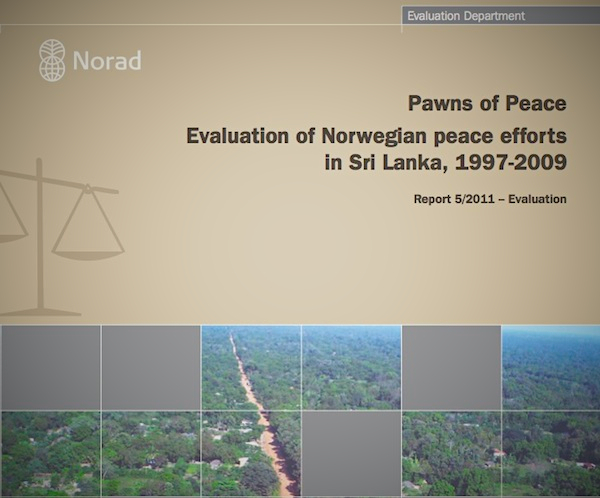The Norwegian (NORAD) commissioned study ‘Pawns of Peace: Evaluation of Norwegian peace efforts in Sri Lanka, 1997-2009’, is useful and good, but analytically flawed at its very core. It is useful because it shows us how the ‘liberal peace’ discourse goes and how that constituency views the conflict in retrospect. This does not mean that this perspective has it all wrong. Indeed the study has quite a few things right. In any case it is crucial that the Sri Lankan readership sees how our contemporary history is perceived and reconstructed. It is useful to look into a mirror, while being conscious as to whether it is a slightly or greatly distorting one. Taken as a whole, the Norwegian study is a valuable and welcome addition to the growing literature on the war and our times—with the strongest part being the analysis of the International Dimension in Chapter 7. In the interest of transparency I should add that I am one of the 84 persons listed as having been interviewed for the study (one of the authors flew over from Europe for a day to the Singaporean think-tank where I was at the time), and have been quoted quite accurately (p 79, fn. 273).
It is however, wrong or empty at its very core. Wrong not only in what it sees and says, but perhaps even more so, in what it does not—in what it fails to or chooses not to see and/or express. The NORAD study is characterised by an absent analytical core. Let us limit ourselves to considering, as a microcosm, a representative sample, these conclusions from the Executive Summary:
“…there was an incommensurable gap between what the South would countenance (a unitary state with limited devolution) and the LTTE demanded (a separate state in all but name)….” (p. xv)
“…The effort led by the United National Front (UNF) government to internationalize the peace process through security guarantees, donor funding and politically sensitive economic reforms sparked a Sinhala-nationalist backlash. This contributed to the emergence of a nationalist-oriented administration, with a commitment to a more hard line position towards the LTTE and greater scepticism towards Western involvement. ” (p. xvi)
This is as inaccurate as it is inadequate. President Chandrika Bandaranaike Kumaratunga was willing to go beyond “a unitary state with limited devolution”. This neither prevented the Tigers from going to war nor did it induce them to stop the war they re-initiated in April ’95 and talk to her about the quasi-federal ‘union of regions package’ (’95-’97). Certainly, it didn’t prevent the LTTE from trying to blow her up, leaving her blinded in one eye. Furthermore, why was a unitary state with devolution acceptable to the IRA/Sinn Fein, which debated and negotiated the limits and extent of that devolution, but was not something that the LTTE would even consider (and the TNA is unwilling to explicitly commit to, even today)? Why did it continue to demand and repeatedly initiate war for ‘a separate state in all but name’ even in the wake of reforms such as the Indo-Lanka accord and against a peace-keeping force from a country with a huge Tamil population? What does that say about the LTTE, from a comparative political perspective? What does Norway’s failure to ask itself the question after the Good Friday agreement, tell us? What indeed does the failure of this post-mortem, to raise that question, reveal?
The second assertion quoted from the executive summary is also wrong or only partially true, and misses the essential point. What, exactly, fuelled the ‘Sinhala nationalist backlash’ to the point of the ‘emergence of nationalist oriented administration’? As public opinion polls of that period (some cited in the study) reveal, support for the UNP administration’s CFA was moderately high at the outset but kept dropping as the LTTE’s lethal violence continued, with the killing even of a police officer in the Dehiwela police station, an army officer on a city street and the much respected Foreign Minister as he took a swim. In sum, was not the real causative factor, the aggressive, deadly behaviour of the Tigers during the CFA, and the pusillanimity of Ranil Wickremesinghe’s UNP, Chandrika Bandaranaike Kumaratunga during her comeback ( Karuna rebellion, PTOMS), and the Norwegians, in the face of such marked aggression? What does the failure of the NORAD analysis to pose this crucial question tell us?
Running through the entirety of the study is the dual argument about (i) two contending nationalisms (or ultra-nationalisms) and (ii) the failure of the Sri Lankan state to reform/restructure. This argument is supported by and often attributed to a few Lankan social scientists. Though containing considerable truth, the dual argument fails to grasp the main thing: as Sartre emphasised, what is most crucial is not what is done to you by others, but what you do with, and about, what is done to you. One is free to choose, and the existential choice one makes tells you about yourself and tells us about you– all the more so if it is a choice that is repeatedly made over time. Not many armed movements faced with the phenomenon of a state that refuses to or is agonisingly slow to reform, respond by assassinating neighbouring peacemakers like Rajiv Gandhi or wiping out competing guerrilla movements and intellectuals who were for federal reforms, such as Rajani Tiranagama and Neelan Tiruchelvam.
Aristotle was the first to point out that one size does not fit all, when he embarked on a comparative study of constitutions of the Greek city states and pioneered the classification of regimes, according to their internal arrangements and ‘animating spirit’ or governing ethos. For many long years I have argued emphatically that the same is true of non-state or anti-state actors.
Thus, the Tigers and their leader were of a qualitatively different category from, say, the Guatemalan guerrillas with whom the Norwegians dealt with in the peace process they successfully mediated.
This is not a prejudiced assumption which should have been made apriori by Norway. It is a conclusion that would have flowed had they undertaken a quite basic task of analysis, namely to study the earlier peace efforts that were made by India and Sri Lanka, and have detailed discussions with the Indian and Lankan negotiators. Even if one assumed ideological–cultural bias on the part of the Sri Lankans, searching conversations with the Indian negotiators of the 1980s (such as India’s man currently on the Security Council) should have been an obvious exercise. That this has not been mentioned or undertaken by the Norwegian study reveals that they are still unaware that they attempted to re-invent a wheel.
In an exercise that is pretty standard in the FBI’s Behavioural Science Unit at Quantico, a study of the LTTE’s conduct during all previous ceasefires and efforts at negotiation would have yielded an unmistakable profile of the movement and its leader.
That in turn, would have helped construct a far less frail and foredoomed effort at peace by Norway. Given the character of the LTTE as analytically derived from its patterns of political (more correctly, politico-military) behaviour, a different and far stronger strategy could have been drawn up by Norway. Such a strategy would have had to be based on concepts of containment and deterrence, not of appeasement; a model emphasising conflict management rather than of conflict resolution. The primary object of containment and deterrence should have been of that party which had repeatedly returned to war– even against a non-Sinhala, secular, quasi-federal mediator (India) and a reform-minded President (Chandrika).
That would have been the Realist option. The last war was not solely the ‘realist’ choice of several available (and implicitly free-floating) options, and to present it as such, reveals a feeble capacity for political analysis. The final war was the sole realist (or real) option left open after the Norwegian failure to adopt a realist model of peace-making deriving from a comprehension of the character of one of the belligerents, itself deducible from (a) the political behaviour of that actor and (b) a comparative political analysis of other armed movements (e.g. Guatemala, El Salvador, Northern Ireland).
This study does not pose, still less grapple with the quintessential political question involved in the Norwegian and other efforts at a negotiated peace in Sri Lanka: how does one make peace with a non-state (therefore unconstrained) actor that is fanatical, politico-ideologically fundamentalist and totalitarian? Is peace possible, in the final analysis, with such an entity? If so, is it not only as a product of prolonged containment and firm deterrence, until that entity evolves/mutates, or decomposes/implodes? If not, surely war is necessary, and if we are to invert Machiavelli who said the only just war is a necessary war, is not a necessary war, a just war?
It is also bad political theory verging on ignorance, to posit, as the Norwegian study and its supportive/feeder studies by Sri Lankan Social Scientists have done, a contradiction between the ‘liberal’ and ‘Realist’ approaches. On the contrary, not only have contemporary Realists credibly counterattacked, dismantling the illiberal neoconservative militarist approach as undermining precisely the national interest, the most outstanding thinkers in the modern Realist tradition have themselves been liberals and reformists (even progressives): George Kennan, Hans Morgenthau, Reinhold Niebuhr, Raymond Aron and Stanley Hoffman to name just those who spring to mind. Moving from such ‘grand strategists’ to contemporary military thinkers, Gen David Petraeus (with whom I had the privilege to dialogue during his presentation in Paris few months back) is a socially liberal Realist.
This is not one-upmanship or hair-splitting. It is the enduring intellectual availability and strong international reassertion of a reformist liberal Realism — ‘post-Neocon Realism’ – that enables a clear understanding of why the Norwegian effort was foredoomed, and why the war had to be fought to win. It sheds light on why, with the domestic abdication or absence of a liberal realist political will to defeat the Tigers and defend sovereignty, leaving the task almost by default to a re-emergent ‘nationalist orientation’, the aftermath was pretty much inevitable. A liberal realist perspective also informs us no less crucially, what must be done, undone and not done, for the peace too to be won.


